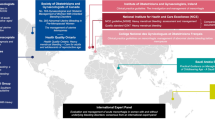Abstract
Pregnancy test strips are widely used in daily life. A commercial pregnancy test strip was modified to obtain a point-of-care device for the detection of pathogenic bacteria. Hybrid nanoflowers were prepared from concanavalin A, human chorionic gonadotropin, and Cu3(PO4)2 via a one-pot method. They were used as signaling probes in an off-the-shelf pregnancy test strip. This modified lateral flow immunoassay can detect Escherichia coli O157:H7 with a detection limit of 4 CFU·mL−1, and Salmonella typhimurium with a detection limit of 3 CFU·mL−1. Conceivably, the method has high potential as a portable and cost-effective tool for rapid determination of a wide range of analytes, especially in resource-constrained settings.

Hybrid nanoflower loaded human chorionic gonadotropin (hCG) and concanavalin A (hCG − nanoflowers) were synthesized via a one-pot method and used as signal labels with commercial commercial-off-the-shelf pregnancy test strips to detect pathogenic bacteria targets, thus yielding an easily smartphone readout signal.




Similar content being viewed by others
Change history
03 October 2018
The published version of this article, unfortunately, contained error. The authors are re-writing to express their sincere apology for a mistake that a mark “10-5, 10-4, 10-3, 10-2, 10-1 CFU•mL-1” in the legend of Fig. 2 was not corrected as “105, 104, 103, 102, 101 CFU•mL-1”.
References
Chen Y, Xianyu Y, Wu J, Dong M, Zheng W, Sun J, Jiang X (2017) Double-enzymes-mediated bioluminescent sensor for quantitative and ultrasensitive point-of-care testing. Anal Chem 89(10):5422–5427. https://doi.org/10.1021/acs.analchem.7b00239
Xie Y, Wei X, Yang Q, Guan Z, Liu D, Liu X, Zhou L, Zhu Z, Lin Z, Yang C (2016) A Shake&Read distance-based microfluidic chip as a portable quantitative readout device for highly sensitive point-of-care testing. Chem Commun (Camb) 52(91):13377–13380. https://doi.org/10.1039/c6cc07928h
Lee SC, Kim MS, Yoo KC, Ha NR, Moon JY, Lee SJ, Yoon MY (2017) Sensitive fluorescent imaging of Salmonella enteritidis and Salmonella typhimurium using a polyvalent directed peptide polymer. Microchim Acta 184(8):2611–2620. https://doi.org/10.1007/s00604-017-2240-1
Rajendran VK, Bakthavathsalam P, Ali BMJ (2014) Smartphone based bacterial detection using biofunctionalized fluorescent nanoparticles. Microchimi Acta 181(15–16):1815–1821. https://doi.org/10.1007/s00604-014-1242-5
Tang R, Yang H, Gong Y, You M, Liu Z, Choi JR, Wen T, Qu Z, Mei Q, Xu F (2017) A fully disposable and integrated paper-based device for nucleic acid extraction, amplification and detection. Lab Chip 17(7):1270–1279. https://doi.org/10.1039/c6lc01586g
Dou M, Sanjay ST, Benhabib M, Xu F, Li X (2015) Low-cost bioanalysis on paper-based and its hybrid microfluidic platforms. Talanta 145:43–54. https://doi.org/10.1016/j.talanta.2015.04.068
Zhang JJ, Shen Z, Xiang Y, Lu Y (2016) Integration of solution-based assays onto lateral flow device for one-step quantitative point-of-care diagnostics using personal glucose meter. ACS Sensors 1(9):1091–1096. https://doi.org/10.1021/acssensors.6b00270
Magiati M, Sevastou A, Kalogianni DP (2018) A fluorometric lateral flow assay for visual detection of nucleic acids using a digital camera readout. Microchim Acta. 185 (6). UNSP 314 https://doi.org/10.1007/s00604-018-2856-9
Hong L, Zhou F, Shi DM, Zhang XJ, Wang GF (2017) Portable aptamer biosensor of platelet-derived growth factor-BB using a personal glucose meter with triply amplified. Biosens Bioelectron 95:152–159. https://doi.org/10.1016/j.bios.2017.04.023
Huang H, Zhao G, Dou W (2018) Portable and quantitative point-of-care monitoring of Escherichia coli O157:H7 using a personal glucose meter based on immunochromatographic assay. Biosens Bioelectron 107:266–271. https://doi.org/10.1016/j.bios.2018.02.027
Xu J, Jiang BY, Xie JQ, Xiang Y, Yuan R, Chai YQ (2012) Sensitive point-of-care monitoring of HIV related DNA sequences with a personal glucometer. Chem Commun 48(87):10733–10735. https://doi.org/10.1039/c2cc35941c
Zhang YN, Xue QW, Liu JF, Wang HS (2017) Magnetic bead-liposome hybrids enable sensitive and portable detection of DNA methyltransferase activity using personal glucose meter. Biosens Bioelectron 87:537–544. https://doi.org/10.1016/j.bios.2016.08.103
Yan L, Zhu Z, Zou Y, Huang Y, Liu D, Jia S, Xu D, Wu M, Zhou Y, Zhou S, Yang CJ (2013) Target-responsive "sweet" hydrogel with glucometer readout for portable and quantitative detection of non-glucose targets. J Am Chem Soc 135(10):3748–3751. https://doi.org/10.1021/ja3114714
Mak WC, Beni V, Turner APF (2016) Lateral-flow technology: from visual to instrumental. Trends Analyt Chem 79:297–305. https://doi.org/10.1016/j.trac.2015.10.017
Du Y, Pothukuchy A, Gollihar JD, Nourani A, Li B, Ellington AD (2017) Coupling sensitive nucleic acid amplification with commercial pregnancy test strips. Angew Chem Int Ed Engl 56(4):992–996. https://doi.org/10.1002/anie.201609108
Lin Z, Xiao Y, Yin Y, Hu W, Liu W, Yang H (2014) Facile synthesis of enzyme-inorganic hybrid nanoflowers and its application as a colorimetric platform for visual detection of hydrogen peroxide and phenol. ACS Appl Mater Interfaces 6(13):10775–10782. https://doi.org/10.1021/am502757e
Ge J, Lei J, Zare RN (2012) Protein-inorganic hybrid nanoflowers. Nat Nanotechnol 7(7):428–432. https://doi.org/10.1038/nnano.2012.80
Liu Y, Chen J, Du M, Wang X, Ji X, He Z (2017) The preparation of dual-functional hybrid nanoflower and its application in the ultrasensitive detection of disease-related biomarker. Biosens Bioelectron 92:68–73. https://doi.org/10.1016/j.bios.2017.02.004
Zhu L, Gong L, Zhang YF, Wang R, Ge J, Liu Z, Zare RN (2013) Rapid detection of phenol using a membrane containing laccase Nanoflowers. Chem Asian J 8(10):2358–2360. https://doi.org/10.1002/asia.201300020
Li WY, Lu SY, Bao SJ, Shi ZZ, Lu ZS, Li CM, Yu L (2018) Efficient in situ growth of enzyme-inorganic hybrids on paper strips for the visual detection of glucose. Biosens Bioelectron 99:603–611. https://doi.org/10.1016/j.bios.2017.08.015
Zeinhom MMA, Wang YJ, Sheng LN, Du D, Li L, Zhu MJ, Lin YH (2018) Smart phone based immunosensor coupled with nanoflower signal amplification for rapid detection of Salmonella Enteritidis in milk, cheese and water. Sensors Actuators B Chem 261:75–82. https://doi.org/10.1016/j.snb.2017.11.093
Acknowledgements
This work was financially supported by the National Key Research and Development Program of China (No. 2016YFD0501001).
Author information
Authors and Affiliations
Corresponding authors
Ethics declarations
The author(s) declare that they have no competing interests.
Electronic supplementary material
ESM 1
(DOCX 772 kb)
Rights and permissions
About this article
Cite this article
Bu, S., Wang, K., Ju, C. et al. A pregnancy test strip for detection of pathogenic bacteria by using concanavalin A-human chorionic gonadotropin-Cu3(PO4)2 hybrid nanoflowers, magnetic separation, and smartphone readout. Microchim Acta 185, 464 (2018). https://doi.org/10.1007/s00604-018-2968-2
Received:
Accepted:
Published:
DOI: https://doi.org/10.1007/s00604-018-2968-2




